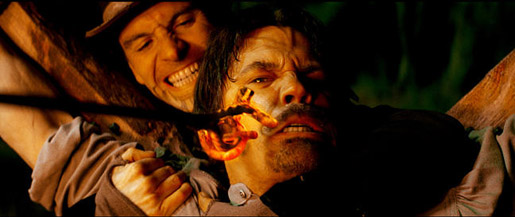Things I Learned From Movie X: Jonah Hex
By Edwin Davies
April 20, 2011
If I didn't think that this was a thrillingly innovative deconstruction of the over-reliance of contemporary cinema on mere visuals to tell stories, I'd almost think that director Jimmy Hayward, a former Pixar animator, was ashamed of his work on the film and wanted to hide as much of it as possible. This argument certainly seems to be buoyed by the closing credits, which appear as if lit by candlelight and, as such, are nearly impossible to read. Perhaps this is yet one further beguiling transgression on the part of Hayward, a total refutation of the auteur theory and the notion that directors, writers and producers can claim credit for the creation of a film, much like Lars von Trier and Thomas Vinterberg's Dogme 95 manfesto? I'm going to go out on a limb here and say that, yes, that is definitely what he was trying to say with the end credits of Jonah Hex.
...Hear No Crappiness
When True Grit came out in December of last year, a common complaint about The Coen Brothers' Oscar-courting oater was that Jeff Bridges' take on Rooster Cogburn made the character too tough to understand. Whilst the slurring, mumbling Cogburn was a touch difficult to comprehend at times, combining as he did the cadence of a common barfly with the outmoded vernacular and rhythms of a lay preacher, Jonah Hex takes things to a whole new level since every character is saddled with a borderline incomprehensible accent or brogue. If the most easily understood character in a film is the guy who has an extra mouth scorched into the side of his face, then there will definitely be a language barrier that viewers must overcome to really get to grips with the material.
Again this could be construed as a conscious effort on the part of Hayward and his team to distract from the words (horrible, horrible words) being spoken by making them almost impossible to comprehend, as well as a way of exploiting the limited range of Future Oscar Winner Megan Fox (Come on Universe, just go ahead and try me! (Damn, still stuck here. Thanks a lot, Cobb!)) by saddling her with an accent (and low-cut corset) that makes sure no one will pay any attention to how flatly she delivers her lines. I, however, choose to believe that the film is merely reflecting the simple, historical fact that diction, like medical X-rays and plastic surgery, was only pioneered after World War I. It's just trying to teach us all a little something about that "other country" known as history, where people spoke funny and fired explosive balls of plasma out of giant, three-barrelled cannons.
It's like, whoa, dude. Seriously. You know?
One area of the film that came in for especially tough criticism was its visual language, which at times makes it unclear whether or not it is cutting between two events taking place at different times and places, or one event taking place at a single location. One glaring example of this is a scene in which Jonah stumbles upon Malkovich In a A Silly Wig's plans to blow up America or whatever, which is then intercut with Malkovich In A Silly Wig describing his plans, only to then reveal that, rather than taking place in the same location at different times, the scene is taking place at the same time and it's just that neither party seems to realize that the other is there.
Once more, I have to take issue with this overly simplistic reading. In both that scene and one at a later point in the narrative, in which Jonah's life-or-death final battle with Malkovich In A Silly Wig is shown both to be happening in the physical realm and in some sort of metaphysical dreamscape that the two share, the film displays its true intentions; that it is an examination of and expansion on the philosophical notion of solipsism, and that it is the latest entry in a discussion that stretches all the way back to René Descartes. In the film's decision to have the fight occur on two separate planes of existence simultaneously, whilst also intercutting images of Jonah's past for seemingly no discernible reason, it seeks to throw off the shackles of objectivism, instead approaching film as a purely subjective form in which the past, present and spiritual life of the central character are shown to exist simultaneously, rather than sequentially.
It's a bold, audacious move that was misinterpreted as incompetence, but in truth, to quote the Bard, the fault lies not in our stars (or film, whatever (Hey, I got out of those parentheses! (Or did I? BWAMMMMM))), dear Brutus, but in ourselves. Like A Square in Edwin Abbott's Flatland, we have encountered something that exists in a dimension our senses will not allow us to comprehend. Bucking the usual trend, Jonah Hex was not shot or converted into 3D, but that was because it has already transcended it, and is the first 4D film, one which combines time and space into a beautiful singularity. Oh, if only I were able to see the world as Jimmy Hayward, who is clearly some advanced trans-dimensional being sent to teach us, does. Curse my pathetic human senses!
I hear that you can appropriate that level of understanding by getting blazed and listening to "The Great Gig in the Sky" backwards, though.
Continued:
1
2
|
|
|
|




